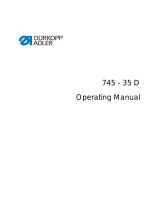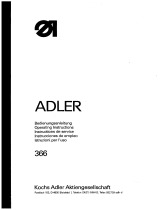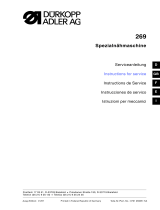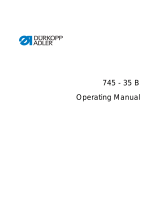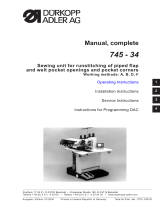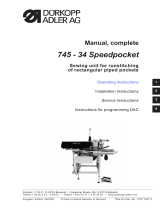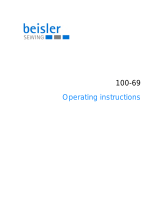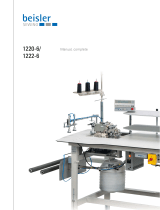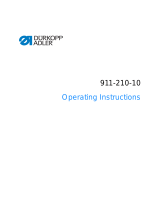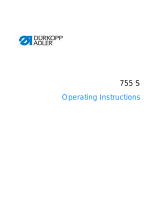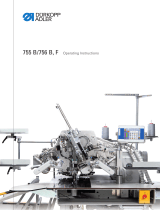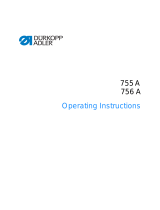Page is loading ...

745 - 34 Speedpocket
Sewing unit for runstitching
of rectangular piped pockets
Operating Instructions
Installation Instructions
Service Instructions
Instructions for programming DAC
Postfach 17 03 51, D-33703 Bielefeld • Potsdamer Straße 190, D-33719 Bielefeld
Telefon +49 (0) 521 / 9 25-00 • Telefax +49 (0) 521 / 9 25 24 35 • www.duerkopp-adler.com
Ausgabe / Edition: Änderungsindex Teile-Nr./Part.-No.:
06/2007 Rev. index: 02.0 Printed in Federal Republic of Germany 0791 745171
1
2
3
4

All rights reserved.
Property of Dürkopp Adler AG and copyrighted. Reproduction or publication of the content in any manner,
even in extracts, w ithout prior written permission of Dürkopp Adler AG, is prohibited.
Copyright ©
Dürkopp Adler AG - 2007

Foreword
This instruction manual is intended to help the user to become familiar
with the machine and take advantage of its application possibilities in
accordance with the recommendations.
The instruction manual contains important information on how to
operate the machine securely, properly and economically. Observation
of the instructions eliminates danger, reduces costs for repair and
down-times, and increases the reliability and life of the machine.
The instruction manual is intended to complement existing national
accident prevention and environment protection regulations.
The instruction manual must always be available at the machine/sewing
unit.
The instruction manual must be read and applied by any person that is
authorized to work on the machine/sewing unit. This means:
– Operation, including equipping, troubleshooting during the work
cycle, removing of fabric waste,
– Service (maintenance, inspection, repair) and/or
– Transport.
The user also has to assure that only authorized personnel work on the
machine.
The user is obliged to check the machine at least once per shift for
apparent damages and to immediatly report any changes (including the
performance in service), which impair the safety.
The user company must ensure that the machine is only operated in
perfect working order.
Never remove or disable any safety devices.
If safety devices need to be removed for equipping, repairing or
maintaining, the safety devices must be remounted directly after
completion of the maintenance and repair work.
Unauthorized modification of the machine rules out liability of the
manufacturer for damage resulting from this.
Observe all safety and danger recommendations on the machine/unit!
The yellow-and-black striped surfaces designate permanend danger
areas, eg danger of squashing, cutting, shearing or collision.
Besides the recommendations in this instruction manual also observe
the general safety and accident prevention regulations!

General safety instructions
The non-observance of the following safety instructions can cause
bodily injuries or damages to the machine.
1. The machine must only be commissioned in full knowledge of the
instruction book and operated by persons with appropriate training.
2. Before putting into service also read the safety rules and
instructions of the motor supplier.
3. The machine must be used only for the purpose intended. Use of
the machine without the safety devices is not permitted. Observe all
the relevant safety regulations.
4. When gauge parts are exchanged (e.g. needle, presser foot, needle
plate, feed dog and bobbin) when threading, when the workplace is
left, and during service work, the machine must be disconnected
from the mains by switching off the master switch or disconnecting
the mains plug.
5. Daily servicing work must be carried out only by appropriately
trained persons.
6. Repairs, conversion and special maintenance work must only be
carried out by technicians or persons with appropriate training.
7. For service or repair work on pneumatic systems, disconnect the
machine from the compressed air supply system (max. 7-10 bar).
Before disconnecting, reduce the pressure of the maintenance unit.
Exceptions to this are only adjustments and functions checks made
by appropriately trained technicians.
8. Work on the electrical equipment must be carried out only by
electricians or appropriately trained persons.
9. Work on parts and systems under electric current is not permitted,
except as specified in regulations DIN VDE 0105.
10. Conversion or changes to the machine must be authorized by us
and made only in adherence to all safety regulations.
11. For repairs, only replacement parts approved by us must be used.
12. Commissioning of the sewing head is prohibited until such time as
the entire sewing unit is found to comply with EC directives.
13. The line cord should be equipped with a country-specific mains
plug. This work must be carried out by appropriately trained
technicians (see paragraph 8).
It is absolutely necessary to respect the safety
instructions marked by these signs.
Danger of bodily injuries !
Please note also the general safety instructions.

Index Page:
Preface and general safety instructions
Part 1: Operating Instructions 745-34 Speedpocket
(Edition: 06/2007)
1. Description of product ........................................ 3
1.1 Description of proper use ........................................ 3
1.2 Briefdescription............................................. 3
1.3 Technicaldata .............................................. 4
1.4 Optional equipment ........................................... 5
2. Operation
2.1 Swingingthefoldingstationaside................................... 7
2.2 Pushing the covering hood back and removing the fabric sliding s heet ............ 8
2.3 Tilting the machine head up ...................................... 11
2.4 Needles and threads .......................................... 12
2.5 Threading in the needle thread .................................... 15
2.6 Winding up the hook thread ...................................... 16
2.7 Changing the bobbins .......................................... 17
2.8 Threadtension.............................................. 19
2.9 Stackingcontrol ............................................. 20
2.10 Cornerknifestation........................................... 21
2.10.1 Swingingthecornerknifestationout/in .............................. 22
2.10.2 Adjustingthecornerknives ...................................... 23
2.11 Referenceposition-Startingthesewingcycle-Quickstop................... 24
2.12 Flapandpipingprojection ....................................... 25
2.13 Piping strip length ............................................ 26
2.14 Workingmethod ............................................. 27
2.14.1 Working method (production of trousers) .............................. 28
2.14.2 Sewingwithflap............................................. 31
2.14.2.1 Sewing without light-barrier ...................................... 31
2.14.2.2 Sewingwithlight-barrier ........................................ 33
3. Functions and operation of the optional equipment
3.1 Remainingthreadmonitor ....................................... 36
3.2 Aligning the light barriers of the bobbin thread monitor ...................... 37
3.3 Blowingdevice.............................................. 39
3.4 Bundle clamp ............................................... 40
3.5 Mounting table extensions ....................................... 41
3.6 Vacuumblower.............................................. 42
3.6.1 Checkingthenominalvoltageofthevacuumblower ....................... 43
3.6.2 Directionofrotationofthevacuumblower ............................. 43
3.6.3 Connection to the factory-own vacuum system ........................... 44
3.7 Mounting the 2
nd
lightbarrier ..................................... 45
1

4. Maintenance
4.1 Cleaning .................................................. 46
4.2 Weeklylubrication............................................ 48

1
1. Description of product
1.1 Description of proper use
The 745-34 Speedpocket is a sewing unit determined to sew light to
medium-weight material, i.e. fabrics made of textile fibers or leather.
These materials are used in the clothing industry.
Generally only dry material should be processed with this machine. It
should not contain any hard objects.
In general, the seam is made with core thread, Polyester fibre or cotton
threads.
The dimensions for needle and hook threads can be taken from the
table in c hapter 2.4.
Before using any other threads it is necessary to estimate the
consequent risks and to take corresponding safety measures, if
required.
This sewing unit must be installed and operated in dry and well-kept
rooms only. If it is operated in other rooms, which are not dry and
well-kept, further measures, which are to be agreed upon, can become
necessary (see EN 60204-31:1999).
We, as a manufacturer of industrial sewing machines, take it for
granted that at least semi-skilled operators will be working on our
products so that we can assume that all usual operations and, where
applicable, their risks are known to them.
1.2 Brief description
The Dürkopp-Adler 745-34S is a sewing unit for runstitching
of rectangular piped pockets.
The piping strips and additional parts are fed manually. Pocket length
20-200 mm (with flap 180 mm max.).
Machine head
–
Twin needle lockstitch execution
–
Large vertical hooks
–
Externally driven center knife
–
Thread trimming device for needle and hook threads
–
Thread monitor for the needle threads
–
DC direct sewing drive
Step motors for the material feed
New generation of c ontrol “DA C III” (DÜRKOPP ADLER Control)
The comprehensive testing and monitoring system MULT ITEST is
integrated in the DAC III.
A microcomputer assumes the control tasks, monitors the sewing cycle
and indicates faulty operation and malfunctions on the display.
5

Optional equipment
See chapter 1.4 (Optional equipment of class 745-34S).
Sew ing equipment and folders
Information about sewing equipment and folders for the various fields
of application can be taken from the Equipment Sheets of
class 745-34S.
Please address your enquiries to the DÜRKOPP-ADLER-sales offices.
1.3 Technical data
Machine head: Class 0246 992003
Needle system: 2134-85
Needle distance: 10, 12 mm
Needle size: Nm 80 to Nm 110
Threads: see table chapter 2.4
Stitch type: Twin needle lockstitch
Speed: min. 2000 r/ min
max. 3000 r/ min
Stitch length: min. 2.0 to 3.0 mm
Number of stitches
condensed stitches: 1 - 10 stitches
Number of stitches
bartack stitch: 0 - 5 stitches
Number of stitches condensed
stitches / bartack: 0.5 - 3.0 mm
Pocket length: max. 200 mm
Operating pressure: 6 bar
Air consumption: approx. 6 NL per work cycle
Nominal voltage: 1 x 230 V (50/60 Hz)
Dimensions: 1540 x 1120 x 1200 mm (L x W x H)
Working height: 790...980 mm
(upper edge of table top)
Weight: 240 kg
6

1
1.4 Optional equipment
Order No. Optional equipment
0792 011161 Mounting kit K
Flap clamp, left, for jackets
0792 011162 Mounting kit K
Flap clamp, right, for trousers
0745 427514 Pincer stacker
Universal stacking device ( pincer stacker)
for stacking to the side
0797 003031 Pressure line
Connection hose to the pneumatic supply line
with corresponding couplings
0246 497534 Remaining bobbin thread monitor
0745 597694 Bundle clamp
with rest table for trousers parts. incl. table extension
(large).
0745 597604 Blowing device
For blowing out the finished parts.
0745 597964 Vacuum blower for the suction device, if there is no
central vacuum system.
0745 597984 Suction device (Vacuum)
For more exact positioning of the material ,
for connection to the central vacuum system.
Note:
If there is no central vacuum system available,
the vacuum blower has to be ordered in addition.
0745 598154 Kit 2
nd
light barrier for applications
Trouser / Jacket
7

8
1
2

2. Operation
2.1 Swinging the folding station aside
For work at the sewing point (threading in the needle threads, needle
change etc.) the whole folding station with folder and light-barriers can
be swung out to the right side.
–
Swingthecompletefoldingstation1withfolder
to the right.
Hint:
With the sewing unit turned on, a safety message appears on the
screen of the control panel.
E r r 9002
Folding station sw ung out
–
The sewing point is freely accessible.
Sw inging the folding station back
–
Swing the folding station back.
ATTENTION !
After the folding station has been swung back, it must lock in catch 2.
1
9

2.2 Pushing the covering hood back and removing the fabric sliding sheet
Caution: Danger of injury!
Switchthemainswitchoff.
Push the covering hood back and remove the fabric sliding sheets only
with the sewing unit switched off.
–
Switchthemainswitchoff.
Pushing the covering hood back
–
Loosen screw 1 of covering hood 2.
–
Push the covering hood 2 to the left.
ATTENTION!
Push the covering hood 2 to the left only so far that the c able 3 o f the
light-barrier is not damaged.
–
Push the covering hood 2 back to the right again.
–
Secure the covering hood 2 against displacement with the screw 1.
Note!
With the covering hood pushed back, a s afety message appears on the
screen of the control panel.
E r r 9004
Covering hood not pushed back.
10
3
21
3

Removing the fabric sliding sheet
For changing the hook thread bobbins:
–
Swing the folding station 4 out by 90°.
–
Lift the fabric sliding sheet 6 in the area of pin 5 and swivel it away
to the left.
For complete removal (for maintenance and setting work):
–
Remove the fabric sliding sheet.
1
11
65 4

12
1
2
1
43
5

2.3 Tilting the machine head up
For maintenance work the machine head can be tilted up.
For this purpose the transport carriage must be in its rear position.
Caution: Danger of injury!
Switchthemainswitchoff.
Tilt the machine head up only with the main switch turned off.
Tilting the machine head up
–
Remove the covering hood 1.
For this purpose lift the covering hood at the front so that the
locking is released. Lift the covering hood off carefully.
–
Swing the folding station 2 out by 90°.
–
Swivel the locking lever 4 up.
–
Lift the fabric sliding sheet 3 at the front and swivel it to the left.
–
Lift the machine head in the area of the head cover and tilt it up
carefully until catch 5 locks. The latch snaps in additionally.
The space under the machine table is accessible for cleaning work.
Sw inging the machine head back
–
Lift catch 5.
–
Swing the machine head back carefully.
Caution: Danger of injury!
Hold the machine head tight until it is completely at rest when lowered.
Danger of squashing your fingers between machine head and table
top.
–
Insert the fabric sliding sheet.
–
Swivel the locking lever 4 down.
–
Tilt the folding station 2 back and insert it.
–
Put the covering hood 1 on again.
1
13

2.4 Needles and Threads
Needle system: 2134-85
Recommended
needle size: Nm 90 for thin material
Nm 100 for medium-weight material
Nm 110 for heavy-weight material
High sewing security and good sewability are achieved with the
following core threads:
–
Two-ply Polyester Continuous Polyester core-spun
(e.g. Epic Poly-Poly, Rasant x, Saba C, ...)
–
Two-ply Polyester Continuous Cotton core-spun
(e.g. Frikka, Koban, Rasant, ...)
In case these threads are not available, the Polyester fibre or cotton
threads listed in the table can also be sewn.
Often two-ply core threads are offered by the thread manufacturers
with the same designation as three-ply Polyester fibre threads
(3cyl.-spun). This causes uncertainty with regard to twisting and thread
thickness.
When in doubt unravel the thread and check if it is twisted 2- or 3-ply.
The label no. 120 on the thread reel of a core thread corresponds
e.g. to the thread size Nm 80/2 (see table values in brackets).
In case of monofilament threads it is possible to use needle threads
and hook threads of the same size. The best results are achieved with
soft and elastic threads (software) of the thread size 130 Denier.
Recommended thread sizes:
Needle size Core thread Core thread
Nm
Needle thread Hook thread Needle thread Hook thread
Polyester Polyester Polyester Cotton
continuous core-spun continuous core-spun
Label No. Label No. Label No. Label No.
90 120 (Nm 80/2) 120 (Nm 80/2) 120 (Nm 80/2) 120 (Nm 80/2)
100 100 (Nm 65/2) 100 (Nm 65/2) 100 (Nm 65/2) 100 (Nm 65/2)
110 75 (Nm 50/2) 75 (Nm 50/2) 75 (Nm 50/2) 75 (Nm 50/2)
Needle size Polyester fibre thread Cotton thread
Nm (3cyl.-spun)
Needle thread Hook thread Needle thread Hook thread
90 Nm 80/3-120/3 Nm 80/3-120/3 Ne
B
50/3-70/3 Ne
B
50/3-70/3
100 Nm 70/3-100/3 Nm 70/3-100/3 Ne
B
40/3-60/3 Ne
B
40/3-60/3
110 Nm 50/3-80/3 Nm 50/3-80/3 Ne
B
40/4-60/4 Ne
B
40/4-60/4
14

Changing the needles
Caution: Danger of injury!
Switchthemainswitchoff.
Change the needles only with the main switch turned off.
Danger of cutting your fingers!
Do not reach into the area of the center knife 3 when changing the
needles.
–
Swing the folding station aside (see chapter 2.1)
The needles are freely accessible.
–
Loosen screw 2 and remove the needle from the needle holder 1.
–
Insert the new needle in the drill-hole of needle holder 1 as far as it
will go.
ATTENTION!
Seen from the operator ’s side, the hollow groove 4 of the left
needle must point to the left and the hollow groove 5 of the right
needle to the right (see sketch).
–
Tighten screw 2.
ATTENTION!
After c hanging over to another needle size the needle protection on the
hook has to be readjusted (see Service Instructions).
Hint:
The standard needle size of class 745-34 is Nm 100 .
1
15
1
2
3
4
5

16
3
4
5
6
7
8
9
12 11 10
17
16
15
14
13
1
2

2.5 Threading in the needle thread
Caution: Danger of injury!
Switchthemainswitchoff.
Thread needle threads in only with the sewing unit s witched off.
The threading-in of the needle threads is done in ascending numerical
order, a s shown in the illustrations opposite:
–
Swing the folding station aside
Left needle
–
Put the thread reel on the thread reel holder.
–
Thread the thread from the thread reel through the d rill-hole 1 of
the thread reel holder.
–
Guide the thread through the guide 2.
–
Guide the thread through the drill-hole in s upport plate 3.
–
Guide the thread through the guide 5.
–
Guide the thread through the tensions discs of needle thread
tension 6.
–
Guide the thread through the thread controller spring 8.
–
Guide the thread through the drill-hole in s upport plate 10.
–
Thread the thread through the drill-hole in thread lever 17.
–
Guide the thread downward through the thread puller 16.
–
Thread the thread through the guide 15, through the needle thread
monitor 14 and through the thread guide 13 (not visible).
–
Thread the thread through the guide 12 (not visible), through the
drill-hole in the needle holder and through the eye of the needle.
Right needle
–
Put the thread reel on the thread reel holder
–
Thread the thread from the thread reel through the d rill-hole 1 of
the thread reel holder.
–
Guide the thread through the guide 2.
–
Guide the thread through the drill-hole in the support p late 3.
–
Thread the thread through the tension disc of the needle thread
tension 4.
–
Thread the thread through the guides 5 and 7.
–
Guide the thread through the thread controller spring 9.
–
Guide the thread through the drill-hole in s upport plate 10.
–
Thread the thread through the drill-hole in the thread lever 17.
–
Thread the thread downward through the thread puller 16, through
the guide 15, through the needle thread monitor 11 and through the
thread guide 13.
–
Thread the thread through the guide 12 (not visible), through the
drill-hole in the needle holder and through the eye of the needle.
–
Clamp the threads in the needle thread catcher and cut them off.
17
1

2.6 Winding up the hook thread
The external bobbin winder allows to wind up the hook threads
independent of sewing.
–
Remove remaining thread from the winder hubs before winding-up.
–
Put the thread reel on the thread reel holder.
–
Thread the thread through the drill-hole 1 of the unwinding arm
(see picture on the left).
–
Guide the thread through the guide 4.
–
Guide the thread through the bobbin thread tension 2.
–
Prewind the thread to the right in the front and hind reserve
grooves of the bobbin hub.
The full reserve grooves guarantee a s ecure winding even with
monofilament threads.
–
Press the bobbin retainer 3 against the bobbin hub.
The winder starts.
After reaching the set bobbin filling quantity the winder stops
automatically.
See the Service Instructions for setting the bobbin filling quantity.
18
43 2
1
/

